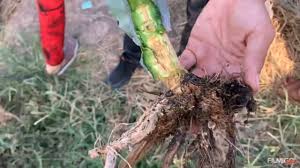Root rot in dragon fruit plants can be a daunting challenge for growers, threatening the health and vitality of these exotic succulents. Characterized by the insidious invasion of fungal pathogens, root rot poses a significant risk to the root system, impairing nutrient absorption and water uptake, ultimately leading to plant decline and mortality.
Table of Contents
Root Rot in Dragon Fruit: Causes, Symptoms, and Management

Unveiling the Culprits: What Causes Root Rot in Dragon Fruit?
The onset of root rot in dragon fruit is often attributed to fungal pathogens, particularly those belonging to the Phytophthora genus. These insidious invaders thrive in conditions of excessive moisture and poor drainage, infiltrating the delicate root system of the plant and wreaking havoc from within.
The primary culprit behind root rot in dragon fruit is excessive soil moisture. In environments where drainage is compromised or irrigation practices are excessive, waterlogged conditions prevail, creating an ideal breeding ground for fungal pathogens. Saturated soils deprive the roots of essential oxygen, impeding their respiratory processes and rendering them susceptible to fungal attack.

Decoding the Symptoms: Recognizing Root Rot in Dragon Fruit
Identification of root rot in dragon fruit hinges upon astute observation and vigilance. Early detection is paramount to implementing effective intervention strategies and salvaging the health of the plant.
Yellowing and wilting of foliage serve as harbingers of root rot in dragon fruit. As fungal pathogens impair nutrient uptake and water transport, leaves exhibit signs of distress, manifesting as a gradual decline in vibrancy and turgidity.
Upon closer inspection, afflicted plants may display darkening and softening of the root system, indicative of fungal colonisation and tissue degradation. The roots, once firm and robust, succumb to the relentless assault of fungal invaders, culminating in a state of decay and dysfunction.

Navigating the Path to Recovery: Managing Root Rot in Dragon Fruit
Combating root rot in dragon fruit necessitates a multifaceted approach encompassing preventive measures and targeted interventions. By fortifying the plant’s defenses and mitigating conducive conditions, growers can safeguard the vitality and resilience of their prized specimens.
1. Enhance Soil Drainage
Amending the soil composition is paramount to thwarting the onset of root rot in dragon fruit. Opt for well-draining substrates such as sandy loam or perlite-enriched mixes, which facilitate the expeditious removal of excess moisture and mitigate the risk of fungal proliferation.
2. Implement Watering Best Practices
Exercise prudence in watering dragon fruit plants, adhering to a regimen that balances hydration with aeration. Allow the soil to dry partially between waterings, preventing the accumulation of moisture that predisposes the roots to fungal infection.
3. Promote Air Circulation
Enhance ventilation around dragon fruit specimens to curtail the stagnation of air and mitigate the risk of fungal spore dissemination. Prune surrounding vegetation and maintain adequate spacing between plants to optimize airflow and reduce humidity levels.
4. Optimize Plant Placement
Strategic placement of dragon fruit plants can mitigate the risk of root rot, circumventing low-lying areas prone to water accumulation. Elevate the planting site or utilize raised beds to enhance drainage and create an inhospitable environment for fungal pathogens.
5. Implement Fungicidal Treatments
In severe root rot in dragon fruit, intervention with fungicidal agents may be warranted to suppress fungal proliferation and salvage the root system. Select fungicides formulated to target Phytophthora species and apply them according to label instructions to minimize phytotoxicity and maximize efficacy.
6. Exercise Vigilance
Regular monitoring is imperative for the early detection of root rot in dragon fruit, enabling prompt intervention and containment of the fungal menace. Conduct routine inspections of the root system, scrutinizing for signs of discoloration, decay, or unusual odors indicative of a fungal infestation.
Conclusion
In conclusion, root rot in dragon fruit poses a formidable challenge to growers, necessitating proactive measures and diligent oversight to mitigate its deleterious effects. By fostering optimal growing conditions and implementing targeted management strategies, enthusiasts can safeguard the health and vitality of their beloved specimens, ensuring a bountiful harvest and years of ornamental enjoyment. Embrace vigilance, empower resilience, and cultivate a thriving oasis teeming with the radiant beauty of dragon fruit.
